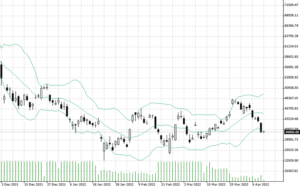

12.04.2022 – Upside-down world: Everyone is talking about inflation. And today’s inflation rate from the US is likely to be horrendous again. So why aren’t cryptos gaining? Until now, e-currencies were considered a protection against the destruction of purchasing power. The riddle’s solution: There is a threat of severe deflation – the collapse of parts of the economy – in the near future.
The consensus among most analysts for the U.S. Consumer Price Index (CPI) in March is currently 8.4 percent. That would be the highest level since January 1982, but at that time the Fed Funds rate was 12 percent – compared to just 0.5 percent now. Which shows that the Federal Reserve has some catching up to do. There are already rumblings on the trading floor about a coming interest rate step of 75 basis points.

Source: Bernstein Bank GmbH
Probably also due to the threat of interest rate steps, BTC has fallen sharply in recent days. The picture shows the daily chart with the Bollinger bands (14). For bulls, the recent drift south is an unpleasant surprise. That’s because over the weekend, the Luna Foundation Guard (LFG), which is a Singapore-based nonprofit, had said it had invested $173 million in BTC and provided hope for support.
Recessionary pressure from politicians
But other institutional investors were not in sight. Which is precisely because of several economic and political uncertainty factors, commented Noelle Acheson, head of the market insight team at Genesis Global, which is a financial platform provider based in Malta. So buyers are holding back. Also, she said, the strength of the DXY is playing a role – the “Dixie” is the dollar index. And there we already have an interesting recession signal: cash is king in deflation and then the dollar is sought above all.
Price target 30,000 for BTC
The “Cointelegraph” also pointed out a bearish word from Arthur Hayes, that is the former head of the trading platform Bitmex. He does not trust central banks in their announcements to fight inflation. This is especially true for the Federal Reserve, he said. Rather, it is a sham maneuver to help politicians against angry citizens. The population is working more, but can afford less and less. Then the bearish price target: “By the end of the second quarter in June of this year, I believe Bitcoin and Ether will have tested these levels: Bitcoin: $30,000, Ether: $2,500.”
Threaded supply chain
So that’s the strange world today: while the current environment is inflationary and therefore actually supportive of cryptos. Bitcoin, after all, cannot be multiplied at will like paper money. And now comes the big but: for many commodities – oil, natural gas, grains, metals – a de facto deflationary global shock event is looming. The World Trade Organization, for example, warned that the Russian war on Ukraine could cost the global economy up to 1.3 percentage points of growth. Gross domestic product is expected to grow by only 3.1 to 3.7 percent in 2022, according to model calculations. We add: In addition, new corona lockdowns in China will add further negative factors.
First inflation, then deflation
The consequence of all this is that when supply chains collapse and the economic engine sputters, investors move out of assets and into cash. Share prices fall. Especially since many people could lose their jobs and need reserves to make ends meet. So inflation is the current danger. And deflation is the big medium-term risk. One thing usually leads to another, because people skimp when prices rise, which ultimately hits industry. Bernstein Bank keeps an eye on the situation for you!
Important Notes on This Publication:
The content of this publication is for general information purposes only. In this context, it is neither an individual investment recommendation or advice nor an offer to purchase or sell securities or other financial products. The content in question and all the information contained therein do not in any way replace individual investor- or investment-oriented advice. No reliable forecast or indication for the future is possible with respect to any presentation or information on the present or past performance of the relevant underlying assets. All information and data presented in this publication are based on reliable sources. However, Bernstein Bank does not guarantee that the information and data contained in this publication is up-to-date, correct and complete. Securities traded on the financial markets are subject to price fluctuations. A contract for difference (CFD) is also a financial instrument with leverage effect. Against this backdrop, CFD trading involves a high risk up to the point of total loss and may not be suitable for all investors. Therefore, make sure that you have fully understood all the correlating risks. If necessary, ask for independent advice. CFDs are complex instruments and are associated with the high risk of losing money quickly because of the leverage effect. 68% of retail investor accounts lose money trading CFD with this provider. You should consider whether you understand how CFD work and whether you can afford to take the high risk of losing your money.7
